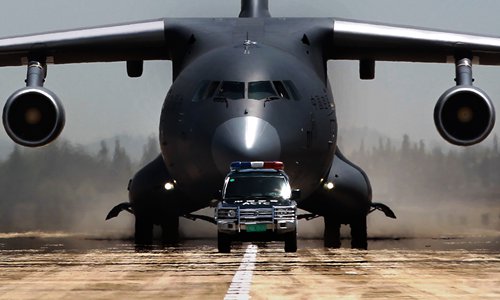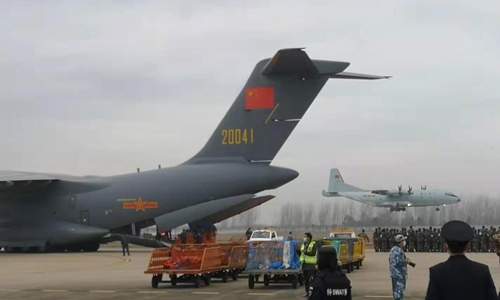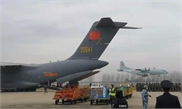
A Y-20 transport aircraft taxis in Chengdu, capital of Southwest China's Sichuan Province on June 16, 2016. Photo: VCG
China's domestically developed large transport aircraft Y-20 for the first time conducted a large-scale military operation in a situation other than war, arriving Thursday in Wuhan, epicenter of the COVID-19 outbreak with medical reinforcements and supplies to join the battle against the epidemic.The arrival of the homemade strategic aircraft has become another confidence boost to the Chinese people, and showed China's determination to eliminate the coronavirus threat as quickly and effectively as possible, analysts said.
A total of 11 transport aircraft of the Chinese People's Liberation Army (PLA) Air Force, including multiple Y-20s, Il-76s and Y-9s, arrived at Wuhan's Tianhe International Airport from multiple locations across China on Thursday morning, carrying a military medical team of 947 people and 74 tons of medical supplies, media reported on Thursday.

Photo: China Military Online
According to a social media post by the Aviation Industry Corporation of China (AVIC), the developer of the domestically produced aircraft, six Y-20s joined the operation.
This is the first time the Y-20 has conducted a large-scale military operation in a situation other than war, and also the first time the PLA Air Force has conducted a large-scale emergency aerial delivery mission systematically featuring large and mid-sized cargo planes, the PLA Air Force said in a statement on Thursday.
The Y-20, with a takeoff weight of up to 200 tons, is a strategic transport aircraft capable of transporting large batches of personnel, equipment and supplies, and has similar functions to the imported Russian Il-76, a military expert who asked not to be named told the Global Times on Thursday, noting that the domestically made Y-20 is not dependent on any other country and is more technically advanced than the Il-76.
To fight the viral outbreak, the PLA Air Force dispatched three transport aircraft to Wuhan on January 24, and eight more arrived on February 2, sending medical teams and supplies that were much needed there. The aircraft used in these two missions were Il-76s.
The deployment of large transport aircraft to fight the epidemic is an indication of China's determination to end the crisis as quickly as possible, as the military has shown a high level of efficiency due to its discipline and expertise, the expert said, noting that the three batches of military transport aircraft deliveries since January showed the Chinese military's strong emergency response and medical support capabilities.
Featuring not only the strategic transporter, the Y-20, but also the domestically made Y-9 tactical transport plane, the operation on Thursday showed the PLA Air Force has a complete family of homemade transport planes, and the two types of aircraft are ready to join any battle, air defense expert Fu Qianshao told the Global Times on Thursday.
Seeing the Y-20, a symbol of China's power in action, has also become a confidence boost for Chinese public.
"Go forward, Chinese military! Let the great hawk spread its wings and expel the plague!" reads a typical comment on the social platform Sina Weibo.
Approved by Chairman of the Central Military Commission Xi Jinping, 2,600 additional medical personnel from the armed forces are tasked with treating patients in two hospitals in Wuhan, the Xinhua News Agency reported on Thursday.
They will treat confirmed patients of COVID-19 infection in Taikang Tongji Hospital with 860 beds and the Guanggu branch of Hubei Maternity and Child Health Care Hospital with 700 beds following the operation model of Huoshenshan Hospital, the first makeshift hospital with 1000 beds established in early February during the epidemic.
Analysts said that the Huoshenshan model means the military would take over the two hospitals, providing effective and comprehensive treatment accompanied with nutritional therapy, psychological counseling and rehabilitation training.
These two hospitals will significantly boost their capabilities in dealing with the epidemic, analysts said.
The first group of 1,400 military medical personnel have arrived in Wuhan on Thursday, and medical treatment is set to begin as soon as possible.
The 2,600 medical personnel are being transferred from several medical institutes from the Army, Navy, Air Force, Rocket Force, Strategic Support Force, Joint Logistics Support Force and Armed Police Force.
As of Thursday, the military had dispatched three groups of more than 4,000 medical personnel to Wuhan since the COVID-19 outbreak began.
Another expert who asked for anonymity told the Global Times on Thursday that the Chinese military with strong capability to organize and mobilize is highly disciplined and possesses the military equipment that can play a special role in treating patients. The military is a timely help, acting as an assault team in the epidemic battle.
Hubei and especially Wuhan are now lacking medical forces and need more manpower and supplies, the expert said, noting that the involvement of the military still cannot reverse the tide immediately, and people from all walks still need to work together.


